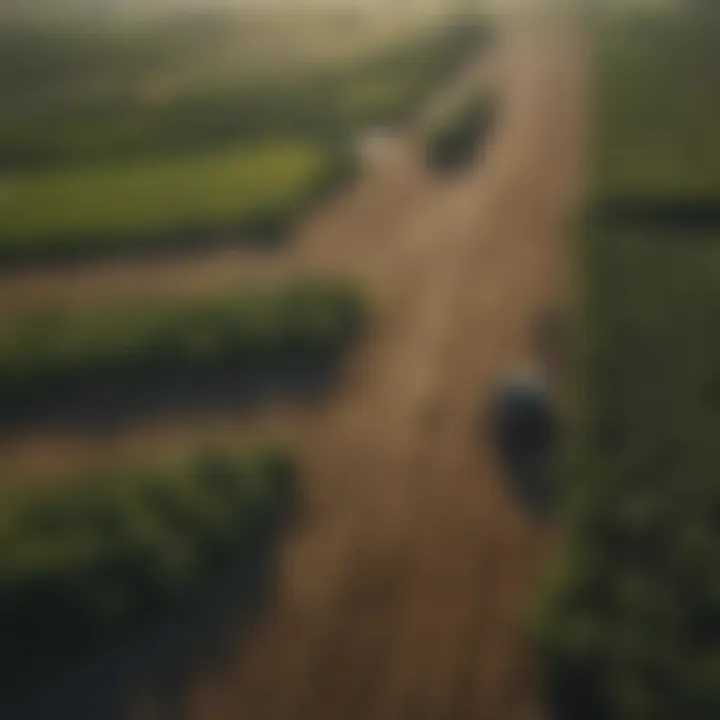Understanding Farmland in Iowa: An In-Depth Exploration


Overview of the Topic
Definition and Importance
Farmland in Iowa plays a crucial role in both local and national contexts. It encompasses various agricultural lands used primarily for the cultivation of crops and the raising of livestock. Given Iowa's strategic location in the Midwest, it is a significant contributor to the United States' overall agricultural output. The state is known for its fertile soil, which supports a diverse range of crops, including corn, soybeans, and oats. Understanding the dynamics of farmland is essential for stakeholders involved in agriculture, as it directly impacts the livelihood of farmers and the economy at large.
Current Trends
In recent years, the landscape of Iowa's farmland has evolved due to shifting agricultural practices, economic pressures, and environmental concerns. Farmers are increasingly adopting sustainable farming techniques to enhance productivity while minimizing negative impacts on the environment. Moreover, there is a growing interest in organic farming and local food systems. This increased awareness has led to more farmers considering crops that not only enrich the soil but also cater to health-conscious consumers.
"Sustainability is not just a choice a farmer can make; it is becoming a necessity for long-term viability."
Key Techniques and Practices
Step-by-Step Guide
To optimize productivity on Iowa farmland, understanding and implementing key agricultural practices is vital. Here’s a simplified guide:
- Soil Testing - Regularly testing soil quality ensures the right nutrients are available. This could involve assessing pH, organic matter, and mineral content.
- Crop Rotation - This involves alternating crops to improve soil health and reduce pest buildup. For instance, rotating corn with soybeans can replenish soil nitrogen.
- Cover Cropping - Planting cover crops during off-seasons can prevent soil erosion and maintain nutrient levels.
- Precision Farming Technologies - Utilize data analytics and GPS tools to make informed decisions about planting densities and irrigation practices.
Tools and Equipment Needed
Farmers in Iowa utilize a range of tools and equipment to maintain and enhance farmland utility. Key items include:
- Tractors and Combine Harvesters for effective planting and harvesting.
- Soil Moisture Sensors to monitor hydration.
- Seeders equipped with precision planting technology to optimize seed distribution.
- Fertilizers and Pesticides that are eco-friendly, to maintain crop health.
Challenges and Solutions
Common Obstacles
Despite the potential for successful farming in Iowa, challenges abound. Issues include:
- Soil Degradation - Intensive farming can lead to nutrient depletion and erosion.
- Climate Variability - Fluctuating weather patterns can negatively impact crop yields.
- Economic Pressures - Market volatility affects profitability, often limiting farmers’ ability to invest in sustainable practices.
Innovative Solutions
Farmers are employing a range of strategies to mitigate these challenges.
- Regenerative Agriculture - This approach focuses on restoring soil health through biodiversity and organic practices.
- Federal and State Support - Accessing subsidies and programs aimed at encouraging sustainable practices can significantly aid farmers.
- Community Collaboration - Engaging with local agricultural groups promotes knowledge sharing and resource management.
The exploration of these dimensions provides valuable insights into the future trajectory of Iowa's farmland. Understanding the current landscape is essential for anyone involved or interested in the agricultural sector.
Overview of Iowa's Agricultural Landscape
Iowa's agricultural landscape is a pivotal aspect of its identity and economy. This section examines the nuances of this landscape, shedding light on how it shapes the lives of residents and contributes to regional prosperity. As one of the leading agricultural states, Iowa boasts a robust system of farming that profoundly influences both local and national food supplies.
The significance of understanding Iowa's agricultural landscape lies in acknowledging several essential elements. Firstly, it encompasses diverse types of farmland, including cropland, pasture land, and woodlands, each serving specific purposes within the agricultural realm. Secondly, the fertility and quality of Iowa's soil plays a critical role in determining what crops can be successfully grown, directly impacting farmers’ livelihoods.
From an economic standpoint, agriculture in Iowa is not only a source of employment but also a critical driver of economic activity. By exploring the relationship between agriculture and the state's economic health, this section helps readers appreciate the interconnectedness of Iowa's farming practices and its broader economic framework. Furthermore, historical practices, trends, and ongoing changes reveal the challenges Iowa farmers face with ongoing climate shifts and market fluctuations.
By providing a clear understanding of the agricultural landscape, this article aims to inform farmers, agricultural professionals, and enthusiasts about the complexities involved in farming in Iowa. This knowledge is crucial for devising sustainable practices and policies that promote long-term viability in this essential sector.
Historical Context
The historical context of Iowa’s agriculture offers valuable insights into how present-day practices and challenges have evolved. Iowa became a significant agricultural hub in the 19th century, primarily due to its fertile soil and conducive climate. The introduction of advanced farming techniques and technologies throughout the years led to increased productivity.
Understanding this history is vital for grasping current issues faced by farmers, such as the impact of industrial agriculture and the move towards sustainable practices. The historical backdrop provides a framework for recognizing the importance of preserving Iowa's agricultural resources for future generations.
Geographic Distribution of Farmland


Iowa’s geographic distribution of farmland is characterized by diverse landscapes that influence agricultural output. The state divides naturally into regions based on soil types, climate, and topographical features. For example, the northern part of Iowa generally features rolling hills and diverse crop production, while the central and southern areas are more flat and predominantly focused on maize and soybean cultivation.
The distribution of farmland also highlights the importance of water resources in irrigation and overall crop management. Water availability can greatly determine land viability and productivity. Farmers must navigate these geographic features to maximize their yield and maintain sustainability. Acknowledging these factors is essential for understanding agricultural operations within the state.
"Iowa’s farmland is not just a vital resource; it reflects the state's commitment to agricultural excellence through centuries of growth, adaptation, and innovation."
By examining these geographical elements, one can better appreciate the pressures and challenges farmers encounter today. Overall, a comprehensive review of Iowa's agricultural landscape underscores the crucial role that historical context and geographic distribution play in shaping local farming practices.
Types of Farmland in Iowa
Understanding the different types of farmland in Iowa is crucial for comprehending the overall agricultural framework of the state. Each type of land serves specific functions and supports varied agricultural practices. This section highlights cropland, pasture land, and woodlands, showcasing their respective roles and contributions to Iowa's agricultural landscape.
Cropland
Cropland occupies a significant portion of Iowa's farmland and is primarily used for growing crops like corn and soybeans. These crops are among the most important for the state's economy. The fertile soil in Iowa allows for high productivity, which directly impacts the supply chains of various agricultural products. The methods used in managing cropland include conventional and no-till farming, each having distinct implications for soil health and sustainability. Moreover, crop rotation is often practiced to maintain soil vitality and reduce pests effectively.
"Iowa ranks first in the nation for corn production and second for soybeans."
The benefits of cropland extend beyond just the immediate yields. Healthy croplands contribute to biodiversity and help mitigate soil erosion. Farmers often adopt technology to monitor soil conditions and optimize yield. This precision in agriculture helps in making informed decisions, improving the sustainability of the practices involved.
Pasture Land
Pasture land plays an essential role in Iowa's agricultural ecosystem, particularly for livestock farming. This type of farmland provides grazing areas for cattle, sheep, and other animals. The management of pasture land includes practices such as rotational grazing, which avoids overgrazing and helps maintain the health of the land. By allowing certain areas to rest, farmers can improve soil quality and forage growth over time.
Additionally, pasture land contributes to the state’s economy by supplying quality meat and dairy products. The sustainability aspect comes into play as well, as well-managed pastures can act as carbon sinks. This means they store carbon rather than releasing CO2 into the atmosphere, which is a resilient characteristic in the face of climate change.
Woodlands
Woodlands represent a different facet of Iowa's farmland, primarily dedicated to forested areas and natural habitats. These spaces offer significant ecological benefits, including wildlife habitat and improved water quality. Woodlands contribute to biodiversity in the region and serve as a counterbalance to the agricultural practices dominating the landscape. Sustainable forest management practices ensure that these areas remain healthy and viable for the long term.
Furthermore, woodlands can provide additional revenue streams for local farmers through timber harvesting and recreational activities. They help in soil conservation, reduce erosion, and support diverse species.
In summary, the various types of farmland in Iowa intersect and work together to support a robust agricultural system. The balance among cropland, pasture land, and woodlands is not just essential for farmers but also contributes to broader environmental health and economic stability.
Soil Quality and Agricultural Practices
Soil quality serves as the foundation of successful farming in Iowa. Without quality soil, crops cannot grow to their full potential, which directly affects yields and, consequently, the economic viability of farms. The health of soil influences both the productivity and the sustainability of farming. It impacts nutrient availability, water retention, and the overall ecosystem balance. Thus, farmers need to understand soil composition and how it relates to agricultural practices.
Soil Composition
Soil composition refers to the various components that make up soil, including minerals, organic matter, water, and air. In Iowa, soils are generally classified into several categories based on their texture and nutrient content. Key attributes include:
- Clay Content: Clay soils tend to retain water well but can be difficult to cultivate. Conversely, sandy soils are well-draining but may not hold nutrients effectively.
- Organic Matter: This is crucial for soil fertility. Higher organic content can improve soil structure, enhancing its ability to support plant life.
- pH Levels: The acidity or alkalinity of soil affects nutrient availability to crops. For instance, most crops thrive in a pH range of 6 to 7.
The local geography plays a significant role in determining soil types across Iowa. For example, the loess hills provide deep, fertile soil, ideal for growing corn and soybeans. Educating farmers about soil composition helps them make informed decisions about crop selection and management practices.
Sustainability Practices
Adopting sustainable practices is vital for maintaining soil quality in Iowa. Today’s farmers face the challenge of balancing productivity with environmental responsibility. Several practices can be implemented to enhance sustainability:
- Crop Rotation: Rotating crops can reduce soil nutrient depletion and help control pests. This method promotes biodiversity.
- Conservation Tillage: Minimizing tillage preserves soil structure and reduces erosion. This not only maintains soil moisture but also encourages healthy microbial activity.
- Cover Crops: Planting cover crops during off-seasons helps prevent soil erosion and enhances nutrient cycling.
"Sustainable practices not only support the environment but ultimately contribute to the long-term productivity of farmland."
Incorporating these methods is essential in ensuring that Iowa's farmland remains viable for future generations. Farmers must understand the interplay between soil quality and agricultural practices, as this knowledge will guide them towards sustainable farming solutions. By focusing on soil health, farmers can optimize yields while also protecting the environment.
Key Crops Grown in Iowa
The cultivation of crops in Iowa plays a vital role in the state's economy and agricultural practices. Understanding which crops are prominently grown can provide insights into farming trends, soil management, and market dynamics. Key crops contribute significantly to both local and national food supply, and examining these elements can reveal the intricacies and challenges faced by farmers in Iowa.
Maize Production


Maize, also known as corn, stands out as the most extensively cultivated crop in Iowa. Its importance cannot be overstated. Iowa consistently ranks at the top for maize production in the United States. The state’s fertile soil and favorable climate make it ideal for growing this crop. Maize serves various purposes, from animal feed to biofuels, and its versatility enhances its relevance in the agricultural sector.
Maize contributes to approximately 25% of Iowa's total agricultural output.
In addition to financial returns, maize production supports a wide network of businesses, including seed supply and farm equipment companies. Farmers often utilize advanced farming techniques such as precision agriculture to optimize yields while managing inputs responsibly. The emphasis on sustainability is becoming more pronounced, with increasing adoption of hybrid corn varieties that are resistant to pests and diseases.
Soybean Cultivation
Soybean is the second most significant crop grown in Iowa. Farmers cultivate soybeans extensively due to their adaptability and market demand. Much like maize, soybeans play a crucial role in animal nutrition and biofuels. Additionally, they are an important source of vegetable oil.
The cultivation of soybeans also enhances soil health. Being a legume, soybean plants fix nitrogen in the soil, which can be beneficial for subsequent crops. Consequently, this practice improves soil fertility without heavy reliance on synthetic fertilizers. Farmers often rotate maize and soybean planting to maintain balanced soil health and achieve efficient crop rotations.
Other Notable Crops
In addition to maize and soybeans, Iowa farmers grow a variety of other crops that play essential roles in local agriculture. Some notable crops include:
- Oats: Often used for animal feed and as a rotation crop to improve soil health.
- Wheat: Grown primarily in the northern regions of the state for both food products and animal feed.
- Alfalfa: A key forage crop that supports dairy and beef production in Iowa.
These crops, while not as dominant as maize or soybeans, contribute to the diversity of Iowa’s agricultural landscape and play crucial roles in supporting both farmer income and ecological health. Understanding these crops and their placing in Iowa's agriculture context helps inform practices that lead to sustainable production.
Economic Impact of Farmland in Iowa
The economic impact of farmland in Iowa is profound. It shapes not only the livelihoods of farmers but also the wider community and state economy. Agriculture serves as a backbone for many aspects of local and statewide development. In Iowa, agriculture generates billions of dollars annually, making it crucial for both rural areas and urban centers.
By understanding the economic contributions of farmland, stakeholders can better appreciate its understanding and advocate for policies that benefit this sector. More than just crop production, the economic activities surrounding farmland foster growth in related industries, create jobs, and sustain local economies.
Contribution to State Economy
Iowa's economy greatly relies on its farmland. It is a major producer of crops such as corn and soybeans, which are essential to both domestic and international markets. The contribution of these crops extends beyond what is visible in the fields. The entire supply chain that supports these crops—fertilizers, seeds, equipment, and transportation—forms a significant part of Iowa's economy.
- In 2021, the total cash receipts from Iowa's agricultural sales reached over $10 billion.
- Approximately 80% of farmland is used for crop production, underscoring its importance.
- Livestock production is another critical component, adding depth to the agricultural profile.
This cycle of agricultural production creates jobs. It supports not only farmers but also equipment manufacturers, transportation services, and food processing plants. Thus, directly and indirectly, farmland fuels Iowa's economic engine, highlighting its multifaceted impact.
Farmland Values and Trends
The value of farmland in Iowa has seen significant trends over the past decades. Prices fluctuate based on factors such as commodity prices, interest rates, and global market demands. The current average value of Iowa farmland is around $8,000 per acre, with some areas even higher.
- Higher demand for crop production can lead to increased land values.
- The rise of sustainable practices influences land valuation, as farmers adopt methods that improve soil health and ecosystem balance.
While the economic outlook appears robust, challenges like climate change and trade policies create uncertainties in farmland values. Factors such as these can greatly influence long-term investments and developmental strategies in the agricultural domain.
Understanding these economic dynamics is essential for anyone involved in Iowa’s agricultural landscape. It reflects the interconnectedness of agriculture with the wider economic spectrum, emphasizing that farmland is not just land; it is a critical investment for the state’s future.
Challenges Facing Iowa Farmers
Iowa farmers play a crucial role in not only the agricultural sector but also the economy and food systems of the United States. However, they are confronted with numerous challenges that threaten their livelihoods and the sustainability of farmland in the region. Understanding these challenges is essential for developing strategies to support farmers and promote agricultural resilience. This section delves into two primary challenges: climate change effects and market volatility.
Climate Change Effects
Climate change is increasingly recognized as a significant threat to agriculture. Farmers in Iowa are experiencing the impacts through unpredictable weather patterns, more extreme weather events, and changing climate conditions.
- Precipitation Variability: The state faces shifting rainfall patterns, with some areas receiving more intense rainfall while others may experience drought conditions. This variability complicates crop planning and increases the risk of crop failure.
- Temperature Increases: Rising temperatures can affect crop yields. Certain crops may not thrive in higher temperatures, leading to decreased production of staples like maize and soybeans. This impacts food availability and farmer incomes.
- Soil Degradation: As weather patterns shift, soil erosion and nutrient depletion become more prevalent. Healthy soil is vital for crop growth, but extreme weather can degrade it. Addressing soil health is crucial for long-term sustainability.
"Farmers need to adapt quickly to these changes or risk losing their farms and way of life," states an agriculture expert.
Market Volatility
Iowa's farmers also contend with market volatility, which can significantly impact their financial stability. Prices for crops can fluctuate based on a multitude of factors, leaving farmers vulnerable to economic pressures.
- Global Market Influence: Farmers are not immune to international commodity markets. Changes in demand from countries like China or Brazil can ripple through to local prices. This can create uncertainty in earnings for Iowa farmers who heavily depend on exports.
- Supply Chain Issues: Disruptions in supply chains, whether due to global crises or domestic challenges, can affect access to necessary inputs. Increased costs for seeds and fertilizers further compound the issue, squeezing farmers’ margins.
- Policy Changes: Shifts in agricultural policies, both at state and federal levels, can alter subsidies or support systems. Farmers must stay informed about policy changes to adjust their strategies accordingly.


Farmers require support to navigate these challenges effectively. Understanding their obstacles allows for more informed decisions on agricultural practices, policy advocacy, and community support to foster resilience in Iowa's agricultural landscape.
Policy and Regulation Overview
Policy and regulation shape the framework within which Iowa's farmland adheres to agricultural standards and practices. Understanding these dynamics is crucial for farmers, policymakers, and stakeholders in the agricultural community. Effective policies can enhance productivity, promote sustainability, and protect valuable natural resources. Regulatory measures aim to balance agricultural interests with environmental considerations. This section will detail the current agricultural policies and the regulatory challenges faced by Iowa farmers.
Current Agricultural Policies
Current agricultural policies in Iowa include both state and federal regulations aimed at fostering a stable agricultural economy. These policies often address crop insurance, conservation programs, and subsidies that support farmers during times of crisis. One notable initiative is the Conservation Reserve Program (CRP), which incentivizes landowners to convert highly erodible land to natural habitats. This effort helps improve soil quality while providing ecological benefits.
Additionally, Crop Insurance programs provide financial protection against loss of crops due to natural disasters or market fluctuations. These programs are essential for Iowa farmers who rely on crop production for their livelihoods. They help mitigate risks associated with farming, encouraging more investment in sustainable practices and technology.
- Subsidies: Can reduce uncertainty for farmers and encourage investment in new methods.
- Environmental Programs: Foster practices that conserve resources and enhance biodiversity.
Understanding these regulations is vital not only for compliance but also for optimizing farm management practices. Farmers who are informed about current policies can make better decisions, ensuring their operations can thrive in a competitive environment.
Regulatory Challenges
While policies can provide several benefits, regulatory challenges often complicate the agricultural landscape. Farmers in Iowa face numerous hurdles, including navigating complex regulations that can seem overwhelming. These challenges include issues with compliance, changing legislation, and the impact of environmental rules.
For example, stringent water quality regulations can limit fertilization practices or impose costs associated with compliance. Farmers may find themselves investing in technology and training to meet these standards, diverting resources from other critical areas of their operations. In many cases, the regulations may not align perfectly with agricultural practices, leading to conflicts.
Moreover, the constantly evolving nature of agricultural policies can create uncertainty. Farmers need to stay updated on changes to maintain compliance and avoid potential penalties.
"Effective communication between policymakers and farmers can ease the burden of regulation while promoting sustainability."
In summary, a thorough understanding of current agricultural policies and the associated regulatory challenges is important for farmers in Iowa. Through informed decisions and adaptations, they can navigate the complexities of the regulatory environment, moving toward sustainable farming practices while securing their livelihoods.
Future of Farmland in Iowa
The future of farmland in Iowa is a multifaceted topic that holds significant relevance for agricultural professionals and enthusiasts alike. Understanding what lies ahead is crucial for sustainable agricultural practices, economic stability, and environmental stewardship. As Iowa continues to be a leader in agriculure, changes in farming practices, technological advancements, and shifts in consumer behavior are all pivotal considerations. These elements not only impact productivity but also shape community ties and the broader economy.
Emerging Trends in Agriculture
In recent years, Iowa has witnessed several emerging trends that are likely to define its agricultural landscape in the near future. Among these trends, agroecological practices are gaining momentum. Farmers are increasingly looking to diversify their crops, integrating cover crops and crop rotation to improve soil health and reduce erosion. Incorporating such practices can lead to more resilient agricultural systems, conserving resources while maintaining high productivity.
Another crucial trend is the increased focus on organic farming. As consumer demand for organically grown products surges, many Iowa farms are exploring organic certification processes. This shift not only caters to market demand but can also enhance profitability through premium pricing.
Additionally, there is significant interest in local food systems. Farmers' markets and community-supported agriculture (CSA) programs are expanding, allowing producers to connect more closely with consumers. This trend fosters community engagement and promotes local economies, bridging the gap between farm and table.
Innovations and Technology
Technological innovations are poised to revolutionize farming in Iowa. Precision agriculture is at the forefront, utilizing satellite imagery, sensors, and data analytics. This technology allows farmers to monitor soil conditions, crop health, and weather patterns in real time. With precise data, farmers can make informed decisions, ultimately enhancing yields and minimizing waste.
Furthermore, advancements in irrigation technology, such as drip and precision irrigation systems, are becoming vital. These systems help conserve water and can lead to increased efficiency in water use. As water scarcity becomes a more pressing concern, such technologies will become essential.
Robotics and automation are also emerging trends. From drones used for crop monitoring to automated planting and harvesting machinery, these innovations can alleviate labor shortages and improve operational efficiency. Although adoption rates may vary, the potential to streamline processes is substantial.
"The fusion of technology with tradition can create more sustainable and productive farmland in Iowa."
Ending
The conclusion of this article serves as a pivotal reflection on the various dimensions of farmland in Iowa. It consolidates crucial insights gathered throughout the previous sections, emphasizing the enduring significance of agriculture to the state's economy and community fabric. This emphasis is not merely academic; it connects the dots between historical practices, modern challenges, and future opportunities in the agricultural sector.
Recap of Key Insights
A synthesis of the key points discussed includes the following elements:
- Historical and Geographic Importance: Understanding Iowa's agricultural landscape begins with its history and the geographic distribution of farmland, which set the stage for modern farming practices.
- Types of Farmland: Iowa houses diverse types of farmland including cropland, pasture land, and woodlands. Each type contributes uniquely to the agricultural ecosystem.
- Soil Quality: The quality of soil is paramount for sustainable agriculture, determining crop health and yield. Sustainable practices enhance soil composition and biodiversity.
- Economic Role: Farmland significantly contributes to Iowa's economy, influencing employment rates, local businesses, and overall community well-being.
- Challenges: Farmers face numerous challenges, such as climate change and market volatility, which require adaptive strategies for resilience.
- Policymaking: Understanding current agricultural policies and regulatory frameworks is vital for navigating the landscape effectively, ensuring farmers can thrive amidst ongoing shifts.
- Future Directions: Emerging trends in agriculture and innovations in technology are shaping the way farms operate, pushing towards more sustainable practices.
Call to Action for Sustainable Practices
In light of the insights provided, it is essential for agricultural professionals and enthusiasts to engage actively in sustainable farming practices. Here are several actions to consider:
- Educate: Stay informed about sustainable methods and agricultural policies. Resources such as Wikipedia, Britannica, and various agricultural forums can provide valuable information.
- Implement: Adopt practices that enhance soil health, reduce water usage, and support biodiversity. This may include cover cropping, crop rotation, and integrated pest management.
- Participate: Join community discussions, either on platforms like Reddit or at local agricultural events, to share experiences and learn from others.
- Advocate: Support policies that promote sustainable practices and equitable access to resources for all farmers in Iowa.
By acting decisively and collaboratively, stakeholders can foster a resilient agricultural landscape in Iowa that not only meets current demands but also safeguards the future of farming for generations to come.



